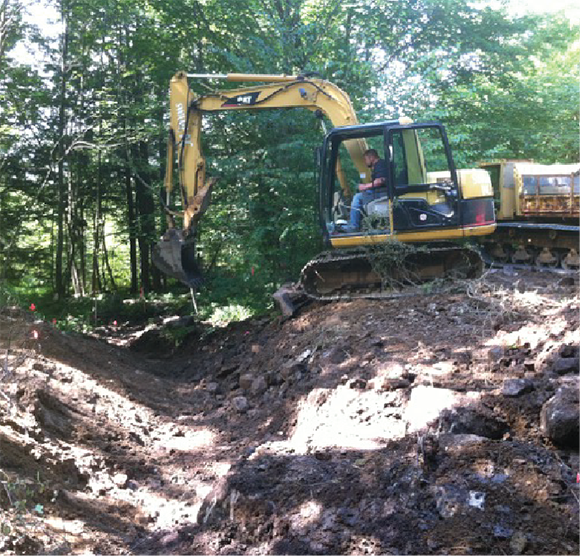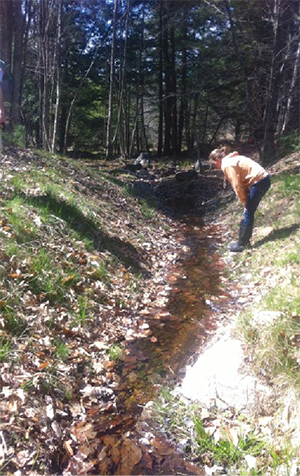PROBLEM | The York Land Trust had purchased a forested parcel that had been logged and quarried and had several streams that were restricted by road crossings. The property is recognized as having prime habitat for Blanding’s and Spotted Turtle populations and is within a key focus area for land and habitat protection in the Mount Agamenticus corridor. In addition, water flows from the property’s rocky uplands to forested wetlands and emergent wetlands then on to Belle Marsh Reservoir, a water supply for the town of Kittery, Maine. A woods road crosses these streams in two locations and the upper stream reach was bisected by a bermed woods road with a blocked culvert which disrupted stream and habitat continuity. An armored channel area (a channel artificially filled with rock to prevent streambed erosion) downstream of the crossing, also limited channelized flow thus compromising both surface water flow and wildlife habitat features.
PROJECT HIGHLIGHTS
- Development of stream and wetland restoration plan
- Stream and wetland restoration
- Turtle habitat enhancement
- Re-establishment of stream flow
CLIENT / COLLABORATORS
- York Land Trust – Client
- Maine Natural Resources Conservation Program (MNRCP)
- Maine Department of Inland Fisheries and Wildlife
- The Nature Conservancy
- Stony Ridge Environmental LLC
- Swamp Inc.


Monitoring visit two years after stream restoration
SOLUTION & METHOD | With funding for the restoration work and permanent conservation of the property provided through the Maine Natural Resource Conservation Program (MNRCP), Truslow RC worked closely with York Land Trust, Maine Department of Inland Fisheries and Wildlife, and the Nature Conservancy, the MNRCP administrator, to successfully complete and implement the restoration plan. Stony Ridge Environmental LLC provided wetland and turtle habitat expertise on the project.
The restoration included modification of wetland edges to allow for better transition between upland and wetland, and removal of a road crossing and re-grading of the stream bank at the upper stream. Re-establishment of channelized flow was accomplished by loosening and repositioning armoring stones and modest channel re-configuration. Stormflow and regular streamflow have re-built the natural stream channel and the stream now flows perennially. Enhancement of turtle nesting habitat adjacent to wetlands was accomplished by keeping existing level clearings adjacent to feeding habitat open and by loosening the soil surface and at suitable sand piles to provide optimal nesting sites. The restoration was successfully implemented during the summer and early fall of 2013.